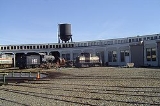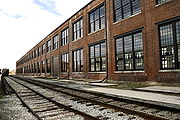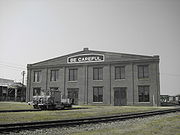
Southern Railway's Spencer Shops
Encyclopedia
Southern Railway's Spencer Shops were a major steam locomotive repair facility between Atlanta
and Washington, D.C.
in Spencer, North Carolina
. The service facility was once Southern Railway's largest steam locomotive repair center. The period of greatest prosperity and productivity for the facility was in the first half of the twentieth century.
These type of repair service facilities for the railroads were called "back shops". They were located in every division of a railroad system and centralized for the most extensive kinds of repairs. The Spencer Shops "back shops" were named in honor of the first president of the Southern Railway, Samuel Spencer
(1847 – 1906), as was the name of the new town developed for these facilities.
The original buildings included a machine shop, storehouse building, office building, wood working shop, and a combination smith and boiler shop. It even had a power plant, an automobile repair facility, and a 37-bay roundhouse where locomotives could be worked on. It employed between 2500 and 3000 at any one time.
The Spencer Shops were located near Salisbury, North Carolina
. The conversion from steam locomotives to diesel locomotives was the demise of the active operations by the railroad of the Spencer Shops. They are now phased out which took place in the 1950s to the 1970s. The former Spencer Shops complex is now part of the North Carolina Transportation Museum
.
created the newly formed Southern Railway Company in 1894 following the financial failure of the Richmond and Danville Railroad
system, which had included the East Tennessee, Virginia and Georgia Railroad
, and several other smaller railroads. The finance company's railroad expert was Samuel Spencer
, who had previously served as superintendent of the Long Island Rail Road
in 1878 and headed the Baltimore and Ohio Railroad
(1887–1888). J. Pierpont Morgan tapped Samuel Spencer to head the new enterprise, one of the largest in the United States.
The new Southern Railway began with two major repair facilities, one in Atlanta, Georgia
, the other in Knoxville, Tennessee
. Much of the inherited rolling stock from the acquisitions of the defunct railroads were in need of major repairs. These two "back shops" service centers could not handle this extensive service need. These facilities were antiquated and poorly equipped and not sufficient for their purposes as Samuel Spencer is quoted of saying. Spencer saw the need for a third major "back shop" service facility on this eastern main line between Washington D.C. and Atlanta. He reported also in the first annual meeting of June 1895 one additional large shop may be necessary. This way the repair facilities would be divided up into segments of about 160 miles (257.5 km) apart. The switch locomotives needed to be inspected for repair and service and refueled at this increment. The new major "back shop" service facility was proposed to be in the middle of these two major cities.

's largest landholder at the time. History records that Henderson entered into secret negotiations with Southern Railway officials for land acquisitions for the proposed major facility to act as a type of front dummy entity to prevent price speculating. He was to buy the land secretly for the new shop complex and sell it back to the railroad at or near the low price he paid. It was already known in 1896 by the public that the Southern Railway was looking for potential land for this facility and at the time the Charlotte area was seen as the logical choice for the complex. It would not seem unusual for the largest county landholder to acquire more land, so this plan of using a "front" person for acquiring large parcels of land for this purpose could keep the real purpose secret from the public. Most thought anyway that the facility was going to be put in the Charlotte area.
In January 1896 Henderson began buying large tracts of land two miles (3 km) north of Salisbury
directly on Southern Railroad's main line. He then sold most of it back to the Southern Railway for slightly more than he paid for it. Henderson did profit however from this secret arrangement. He sold land that he owned in this area to other people that worked for the shops. At the turn of the century he even sold some land back to Southern Railway for a large profit that he had kept for himself.
The workmen constructing the shops began on March 23, 1896, turning the first shovels of 75000 cubic yards (57,341.6 m³) of dirt moved in the construction. It opened for business on August 19, 1896, with Samuel Spencer presiding at the opening ceremonies.

Atlanta, Georgia
Atlanta is the capital and most populous city in the U.S. state of Georgia. According to the 2010 census, Atlanta's population is 420,003. Atlanta is the cultural and economic center of the Atlanta metropolitan area, which is home to 5,268,860 people and is the ninth largest metropolitan area in...
and Washington, D.C.
Washington, D.C.
Washington, D.C., formally the District of Columbia and commonly referred to as Washington, "the District", or simply D.C., is the capital of the United States. On July 16, 1790, the United States Congress approved the creation of a permanent national capital as permitted by the U.S. Constitution....
in Spencer, North Carolina
Spencer, North Carolina
Spencer is a town in Rowan County, North Carolina, United States, incorporated in 1905. As of the 2000 census, the town population was 3,355.-History:...
. The service facility was once Southern Railway's largest steam locomotive repair center. The period of greatest prosperity and productivity for the facility was in the first half of the twentieth century.
These type of repair service facilities for the railroads were called "back shops". They were located in every division of a railroad system and centralized for the most extensive kinds of repairs. The Spencer Shops "back shops" were named in honor of the first president of the Southern Railway, Samuel Spencer
Samuel Spencer (Southern Railway)
Samuel Spencer was an American civil engineer, businessman, and railroad executive. With an education interrupted by service in the Confederate cavalry late in the American Civil War, he completed his education at the University of Georgia and the University of Virginia.Spencer spent his career...
(1847 – 1906), as was the name of the new town developed for these facilities.
The original buildings included a machine shop, storehouse building, office building, wood working shop, and a combination smith and boiler shop. It even had a power plant, an automobile repair facility, and a 37-bay roundhouse where locomotives could be worked on. It employed between 2500 and 3000 at any one time.
The Spencer Shops were located near Salisbury, North Carolina
Salisbury, North Carolina
Salisbury is a city in Rowan County in North Carolina, a state of the United States of America. The population was 33,663 in the 2010 Census . It is the county seat of Rowan County...
. The conversion from steam locomotives to diesel locomotives was the demise of the active operations by the railroad of the Spencer Shops. They are now phased out which took place in the 1950s to the 1970s. The former Spencer Shops complex is now part of the North Carolina Transportation Museum
North Carolina Transportation Museum
The North Carolina Transportation Museum is a transport museum in Spencer, North Carolina.The museum is largely devoted to the state's railroad history, however its collection also includes exhibits of automobiles and aircraft....
.
History
The financial firm of Drexel, Morgan and CompanyJ.P. Morgan & Co.
J.P. Morgan & Co. was a commercial and investment banking institution based in the United States founded by J. Pierpont Morgan and commonly known as the House of Morgan or simply Morgan. Today, J.P...
created the newly formed Southern Railway Company in 1894 following the financial failure of the Richmond and Danville Railroad
Richmond and Danville Railroad
The Richmond and Danville Railroad was chartered in Virginia in the United States in 1847. The portion between Richmond and Danville, Virginia was completed in 1856...
system, which had included the East Tennessee, Virginia and Georgia Railroad
East Tennessee, Virginia and Georgia Railroad
The East Tennessee, Virginia and Georgia Railroad was a rail transport system that operated in the southeastern United States during the late 19th century...
, and several other smaller railroads. The finance company's railroad expert was Samuel Spencer
Samuel Spencer (Southern Railway)
Samuel Spencer was an American civil engineer, businessman, and railroad executive. With an education interrupted by service in the Confederate cavalry late in the American Civil War, he completed his education at the University of Georgia and the University of Virginia.Spencer spent his career...
, who had previously served as superintendent of the Long Island Rail Road
Long Island Rail Road
The Long Island Rail Road or LIRR is a commuter rail system serving the length of Long Island, New York. It is the busiest commuter railroad in North America, serving about 81.5 million passengers each year. Established in 1834 and having operated continuously since then, it is the oldest US...
in 1878 and headed the Baltimore and Ohio Railroad
Baltimore and Ohio Railroad
The Baltimore and Ohio Railroad was one of the oldest railroads in the United States and the first common carrier railroad. It came into being mostly because the city of Baltimore wanted to compete with the newly constructed Erie Canal and another canal being proposed by Pennsylvania, which...
(1887–1888). J. Pierpont Morgan tapped Samuel Spencer to head the new enterprise, one of the largest in the United States.
The new Southern Railway began with two major repair facilities, one in Atlanta, Georgia
Atlanta, Georgia
Atlanta is the capital and most populous city in the U.S. state of Georgia. According to the 2010 census, Atlanta's population is 420,003. Atlanta is the cultural and economic center of the Atlanta metropolitan area, which is home to 5,268,860 people and is the ninth largest metropolitan area in...
, the other in Knoxville, Tennessee
Knoxville, Tennessee
Founded in 1786, Knoxville is the third-largest city in the U.S. state of Tennessee, U.S.A., behind Memphis and Nashville, and is the county seat of Knox County. It is the largest city in East Tennessee, and the second-largest city in the Appalachia region...
. Much of the inherited rolling stock from the acquisitions of the defunct railroads were in need of major repairs. These two "back shops" service centers could not handle this extensive service need. These facilities were antiquated and poorly equipped and not sufficient for their purposes as Samuel Spencer is quoted of saying. Spencer saw the need for a third major "back shop" service facility on this eastern main line between Washington D.C. and Atlanta. He reported also in the first annual meeting of June 1895 one additional large shop may be necessary. This way the repair facilities would be divided up into segments of about 160 miles (257.5 km) apart. The switch locomotives needed to be inspected for repair and service and refueled at this increment. The new major "back shop" service facility was proposed to be in the middle of these two major cities.

Secret negotiations, building at a new location
The development of the facilities for Spencer Shops started with John Steele Henderson. He was a Confederate veteran, a former state senator and Rowan countyRowan County, North Carolina
-Demographics and economics:As of the census of 2010, there were 138,428 people, 53,140 households, and 37,058 families residing in the county. The population density was 270.7 people per square mile . There were 60,211 housing units at an average density of 117.7 per square mile...
's largest landholder at the time. History records that Henderson entered into secret negotiations with Southern Railway officials for land acquisitions for the proposed major facility to act as a type of front dummy entity to prevent price speculating. He was to buy the land secretly for the new shop complex and sell it back to the railroad at or near the low price he paid. It was already known in 1896 by the public that the Southern Railway was looking for potential land for this facility and at the time the Charlotte area was seen as the logical choice for the complex. It would not seem unusual for the largest county landholder to acquire more land, so this plan of using a "front" person for acquiring large parcels of land for this purpose could keep the real purpose secret from the public. Most thought anyway that the facility was going to be put in the Charlotte area.
In January 1896 Henderson began buying large tracts of land two miles (3 km) north of Salisbury
Salisbury, North Carolina
Salisbury is a city in Rowan County in North Carolina, a state of the United States of America. The population was 33,663 in the 2010 Census . It is the county seat of Rowan County...
directly on Southern Railroad's main line. He then sold most of it back to the Southern Railway for slightly more than he paid for it. Henderson did profit however from this secret arrangement. He sold land that he owned in this area to other people that worked for the shops. At the turn of the century he even sold some land back to Southern Railway for a large profit that he had kept for himself.
The workmen constructing the shops began on March 23, 1896, turning the first shovels of 75000 cubic yards (57,341.6 m³) of dirt moved in the construction. It opened for business on August 19, 1896, with Samuel Spencer presiding at the opening ceremonies.

Town of Spencer
Spencer Shops had a small army of thousands of workers. There were skilled workers as well as engineers, firemen, brakemen, and conductors. Many of these settled down in the area and the town of Spencer was formed. Initially Southern Railway partitioned 84 acres (339,936.2 m²) into 500 lots. They were 50 × 145 for residential lots and 25 × 145 for commercial lots. They sold for $100 each. The 625 residents of Spencer were granted incorporation by North Carolina legislature in 1901.External links
- Railroad lines abandoned by the Southern Railway
- Southern Railway Historical Association containing Spencer Shops history
Further reading
- "Southern Railway in Color Volume 2" by Alton Lanier. Published by Morning Sun Books Inc. ISBN 1-58248-014-1.
- "The Southern Railway Remembered" by James Leslie Hepler, publisher Motorbooks International, ISBN 1-8830896-3-8.
- The Southern Railway: Road of Innovators by Burke Davis, University of North Carolina Press (1985), ISBN 0-8078163-6-1
- "Southern Railway Panorama" by Frederick A. Kramer. Published by Quadrant Press, Inc., New York, ISBN 0-9152762-0-8
- "Southern Railway Varnish 1964 - 1979" by Ralph Ward, Original at University of North Carolina, Chapel Hill, ISBN 0-9622999-2-8.
- The Southern Railway System An Illustrated History by William Webb. Published by The Boston Mills Press. ISBN 0-919783-19-8.
- The Southern Railway Steam - Locomotives and trains 1935 - 1937 from the collection of Robert K. Durham, ISBN 0-9644480-6-8.
- "Southern Railway in Color " by Fred Cheney and David R. Sweetland. Published by Morning Sun Books Inc. ISBN 1-878887-14-9.
- "Southern Railway Color Guide to Freight and Passenger Equipment" by James Kinkaid. Published by Morning Sun Books Inc. ISBN 1-878887-60-2.
- "Southern Railway System A Pictorial Album Washington to Atlanta, 1960 - 1982" by Douglas B. Nuckles, Four Way West Publications, ISBN 1-885614-09-8.

